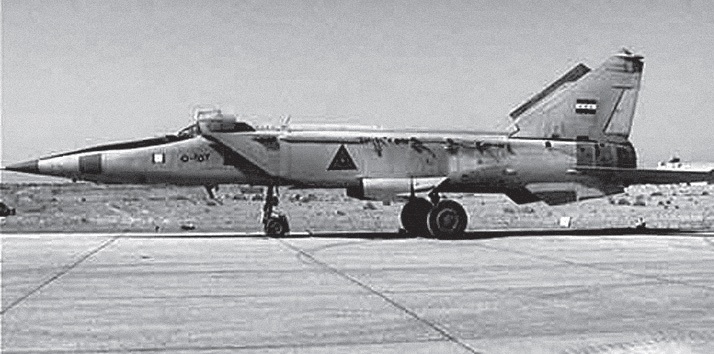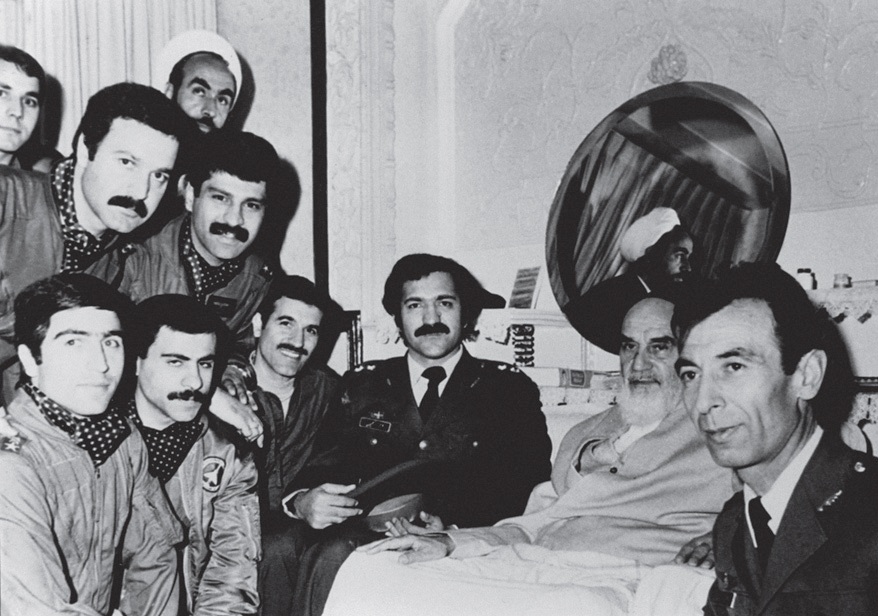Air Raid to Al-Waleed (35)
The Story of Demolishing Fighters and the Equipment in Al-Waleed Triple Military Bases Known as H-3
2016-9-3
Air Raid to Al-Waleed (H-3)
The Story of Demolishing Fighters and the Equipment in Al-Waleed Triple Military Bases Known as H-3
By: Brigadier General Ahmad Mehrnia
Tehran, Sooreh Mehr Publications Company
2010 (Persian Version)
Translated by: Zahra Hosseinian
Echoes of the operation of air raid to Al-Waleed
The result of air raiding to the three bases of northern, eastern, and southern al-Waleed was destruction of more than 48 different types of aircrafts such as, Tu-22, Tu-16, MiG-23, Su-20 and other types of aircrafts and key equipment, plus several types of helicopters and some radar systems which had been deployed to Al-Waleed to avoid air strikes. The incident became the major news of media very soon and was considered at the farthest region around the world. The most important aspect of it was the state of traversing such a long route, given the available equipment and the heavy conditions of the time.
In addition to demonstrating optimal superiority of Iran Air Force, destruction the spirit of Iraqi forces, including air and ground forces and irreparable damages to the enemy army, the raid had various echoes and implications as well.

Damaged MiG-25, this type of aircraft bombed Tehran and other targets in depth of Iran from high-altitude.
Immediately after successful implementation of this operation, the general staff of the Islamic Republic of Iran issued its 457 number announcement as follow. And at the evening of the same day, IRIB broadcasted the news of this tremendous achievement for Iranian nation and all people around the world who monitored the situation of war. The announcement was as follow:
"At the current day (April 4, 1981), agile eagles of Iran sky, honorable pilots of Islamic Republic of Iran Air Force, strike the biggest blow to the evil and murderous body of enemy in a thunderous raid. And in an admirable daringly operations deep inside the Iraq, they destroyed four enemy bases with their all aircrafts, and all returned to Islamic homeland safety and with pride.
General staff of Islamic Republic of Iran congratulated this great victory to the Imam Mahdi (AS) and his deputy, Imam Khomeini, and the Islamic Iranian nation; and also appreciated the brave and self-sacrificed pilots, as well as all the staff of Islamic Republic of Iran Air Force who bravely achieved this success in the light of blessings of God. "
General Staff of the Islamic Republic of Iran
It should be noted that the four bases in the above statement had meant three bases of Al-Waleed and Kirkuk refinery.
In the military statement No. 296, Iraq also declared the Iran’s air raid as follow:
"Enemy aircrafts attacked targets and residential, military, and civilian regions today and then fled from the sky of area when facing our ground defense.
1. At 11:45, they attacked residential areas in Kirkuk. Our casualties were two killed and 23 injured civilians and damaging two residential houses.
2. At 12:30, they attacked one of our airports near the Syrian border from inside the Syria territory.[1]"
On April 9, 1981, ‘Ettelaat newspaper’ had reported that newspapers such as The Financial Times, The Guardian, and The New York Times also inserted the big news; and considered Iranian bombers’ raid as an attempt to destroy Iraqi forces and to show unlimited power of Iranian fighter aircrafts’ aerial operations in Iraq territory.
In the terms of this air raid, Iraqi ‘aljoumhouria newspaper’ accused Damascus to involvement and cooperation with Iran and declared, "Iranian fighters have used Syria territory to attack the Al-Waleed bases." A translated part of this newspaper is as follows:
"Iranian Phantom aircrafts, which have raided western state airports at the borders of Iraq and Syria and Jordan, had flown from Syria, and as soon as the Iraqi air defense forced them to flee, they withdrew toward Syria.
Syrian regime not only has trained Iranian regime agents and supplied the enemy with different military equipment, but also has betrayed and allowed Iranian bombers to invade Iraq facilities from their soil. (Pars news agency quotes from AFP from Baghdad, April 7, 1981) .
On April 9, 1981, other news was published by Pars News Agency quoted from AFP: ‘last night, in Iraq's television, a spokesman from Iraqi army declared that Iranian aircrafts which bombed Iraqi military airports last Thursday in two stages, probably have used Syrian territory. He then said that Iran's closest airport is at least 800 kilometers far away from Iraq airports (Al-Waleed bases) and the maximum range of Phantoms is 500 kilometers. The source concluded that the Phantom fighters of Iran have used Syrian territory for their re-raid Iraqi airports.
Of course, one of Syrian General Intelligence Directorate described that these reports, which are published by Iraqi presses and said that Iranian aircrafts air raided from Syria territory, are so ridiculous that even have no value to be contradicted.
This story, however, continued till April 10, 1981, when according to Radio Amman, Secretary-General of Arab League received a written memorandum from Saadoun Hammadi, Iraq's foreign minister, regarding the participation of the Syrian regime in invading one of Iraqi military bases. In this memorandum, in which the Iraq had demanded its releasing to other Member States, the Syrian behavior was seen as aggression and violation of the charter of Arab League. Also, in the news it could be read: "Following the surprise air raiding of Islam army’s fighters to four army air base deep inside the country, after arresting the radar authorities of above bases, six of them were executed. In addition to confirming above news, an informed source said that six Iraqi officers, who were at radar station, were executed because they had not realized the entrance of Iranian fighters into the country territory. In this regard, 23 other officers have been arrested that probably they also will be executed.[2]"
In response to this unique mission and in the first open session of 1981, Hojjat al-Eslam Ali Akbar Hashemi Rafsanjani, chairman of the Islamic Consultative Assembly said, while praising the heroic pilots of Air Force operations and pointed to the importance of this surprisingly mission:
"While Saddam's mercenary army launches missiles toward the heroic people of Ahvaz, Dezful and Ilam, Air Force heroes answered properly to these brutal and shameless Saddam’s attacks."
In his important speech at Jamaran hussainia about Al-Waleed operations, Supreme Leader of the Islamic Revolution stated:
"I must appreciate and thank the forces that are at war ... the Air Force showed an unprecedented courage, and their fighters went to the last point of Iraq, where they defeated them. On behalf of all nation (I hope that the people give me such a right), I should thank all the fighters and servants, who are sacrificing their lives for Islam and the country in borders, and people back them. Thankfully ... they showed an outstanding bravery, and without inflicting damages to themselves, they beat the Iraq; and made it clear that if there was no fear about innocent people’s being trampled (They liked Iraqi people) … if there was not such fright, they made it clear that the Iraqi government is not worthy of standing in front of our youth. The army commanders were here yesterday, when they wanted to go, Mr. Fakouri, commander of the Air Force, told me secretly that they are going to do one thing and didn’t mention what they want to do, and then it turned out that this extremely important mission has been carried out, and they have hardly chastised Saddam’s fan."

Another photo from meeting of Air Force pilots and staff with the late leader of the Revolutionary on April 1981; respectively from right: sub Lt. Sepehr Kharazian, Imam Khomeini, Qasim Golcheen, Shahid Mahmoud Khazraei, Mohammad Javanmardi, Shahid Gholam Abas Rezaei Khosravi. Back: Shahid Mohammad Reza Azarfar, Shahid Mohammad Ali Akbarpour Sarabi, Asghar Bagheri, Hojjat-ol-Islam Mohammadi Golpayegani.
On April 6, 1981, according to 6th February 1981, Financial Times newspaper wrote:
"Yesterday, Mr. Fakouri, Iran's Defense Minister said that Iranian aircrafts destroyed far-flying fighters in Iraq base near the Jordanian border to show that no point of Iraq is safe from (attacks of) Iran's air force.[3]"
According to AFP from Cairo, the Egyptian weekly, October, wrote on April 11, 1981:
"During air raiding of Air Force fighters of Iranian Army to military bases in Iraq, almost all Iraqi Tupolev has been destroyed."
Referring to Al-Waleed operations, Colonel Javad Fakouri, then air force commander, said in a ceremony:
"Now the nation of Iran can assess their air forces by implementing such operations."
To be continued…
[1]. Saeed Pourdarab; history calendar of Sacred Defense; Volume VIII; Islamic Revolution Documents Center; pp. 297 and 212
[2]. Saeed Pourdarab; history calendar of Sacred Defense; Volume VIII; Islamic Revolution Documents Center; pp. 297 and 298
[3]. translator Group of Sacred Defense Research Institute of Science and Education - National Library of Iran (Iran-Iraq war from the perspective of international press) - sixth volume, the publication of Preservation of Sacred Defense Works and Values, P. 240
Number of Visits: 9007








The latest
Most visited
- Third Regiment: Memoirs of an Iraqi Prisoner of War Doctor – 8
- 100 Questions/7
- The 372nd Night of Memoires– Part 2
- The Role of Objects in Oral Narrative
- 100 Questions/ 8
- Pak-Setan (Clean-Seeker)
- Third Regiment: Memoirs of an Iraqi Prisoner of War Doctor – 9
- The Relationship between “Religious Jurisprudence” and “Oral History”
Challenges of Interviewing in Oral History
After years of studying the theoretical foundations of oral history, conducting numerous interviews and going through their post-interview stages, as well as reading the available body of oral history literature, I was eventually given the opportunity to evaluate the edited versions of dozens of oral history projects.Comparing the Narratives of Commanders and Ordinary Combatants in the Sacred Defense
An Analysis of Functions and ConsequencesThe experience of the Sacred Defense cannot be comprehended merely through statistics or official reports; what truly endures from war are the narratives of those who stood upon its frontlines. These narratives, however, vary significantly depending on one’s position, responsibilities, and lived experience.
Unveiling of the book "Oral History: What and Why"
The First report: Alireza KamariAccording to the Oral History website, the unveiling ceremony of the book "Oral History: What and Why" by Hamid Qazvini was held on Sunday evening, November 24, 1404, in the presence of experts in the field of oral history in the Salman Farsi Hall of the Arts Center.


